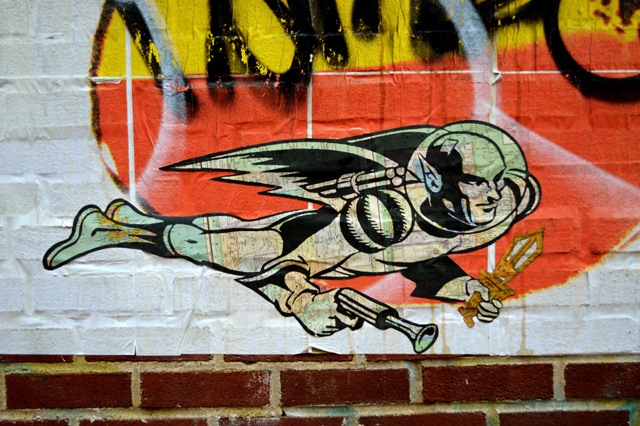
Stikman and Droid: On the Importance of Illegality in Their Work, an introduction by ekg
a few weeks ago, i was asked by RJ to do an interview with Stikman, which would be published on Vandalog during the month of august, 2013. first and foremost, i was thrilled to be interviewing Stikman, a long-time friend, and longer-time Street Art hero of mine. of secondary interest, over the past year, i’ve been working on an epic essay called Anti-Legal Art: On the Importance of Illegal Aesthetic Manifestations in the Twenty-First Century, so i thought this might be a good opportunity to collect some first-hand data on that topic from one of the lifetime-dedicated, constantly up and consistently innovative street artists today. no matter what else is going on, he is always up with new series and new materials, which has cemented in my mind his dedication to the medium, embodied in his consistent efforts for the past twenty plus years to disseminate his sign, spread the word, and challenge the law.
with a weird subtle quiet alien language, Stikman has been leaving a cosmic trail of lo-res multimedia crumbs throughout the urban semiotosphere for us to discover and decipher. his main icon is an alien form rendered with primitive materials in an infinity of mutations and environments. in a sense, Stikman operates much like a tagger in terms of his obsession with constantly being up, the wide dissemination of his mark, and the large quantity of his small-to-tiny pieces. but instead of markers and spray paint, Stikman utilizes alternative materials to disseminate his character, such as wood, metal, glass, and other sculptural elements recovered from the trash, as well as wheat pastes, printed and hand-made stickers, computer-manipulated mutations in all mediums, photographic and illustration fictional environments, and other interesting series as well. unlike a graffiti writer, Stikman does not utilize letterforms, but his primitive alien could be defined as a “character,” which quickly became an important element in the writer’s palette during the seventies as the movement grew in size and diversity of talents.
more often than not Stikman chooses small humble spots for his offspring: the alcove of a steel girder; floating almost unnoticeable in the middle of a peeling sticker mess; forgotten rusty metal boxes; underneath staircases in the dark; inside a missing-brick nook; yet all right under our noses in highly congested urban display hubs. sometimes as large as life, but more often as an invasion of miniatures, totemic and other worldly, charismatic and resonant, significant. does the primitive expression of a futuristic character inspire paradoxical feelings of nostalgia for a simpler earth bound time but at the same time create a yearning for an alien saviour to save us from ourselves? or does it emote a sensation of elation as in the moments of a visionary scientific discovery through alien contact? or is it simply a sign that encapsulates a relief that the alien isn’t a member of the slimy bloodthirsty hordes like a majority of our movies promote as the dominant dystopic mythology? whatever theoretical narrative can be applied to our attraction to these graphic alien insurgents, they have landed, been building underground support, attracting a large vocal segment of our population that is excited about it.
in my recent paris travelogue, i wrote that i feel like Johnny Appleseed as i disseminate marks. this concept of a writer or street artist sprinkling tags or stickers around a city like the iconic Johnny Appleseed flinging his seeds from his sack in an anarchistic, unsanctioned trail behind him across the rural landscape, first occurred to me during a conversation about Stikman’s series of municipal street adhesives. he literally walks around dropping those thick adhesive aliens onto the asphalt in crossing walks and parking spots as if it was a fertile bed of dirt in which his alien flowers will pollinate, mutate and grow, due to the constant motion and weight of traffic passing over them. like a twenty-first century Johnny Appleseed, Stikman releases his beings into cultural consciousness on the anarchistic and rebellious broadcast channel of Street Art; and yet still transmits a quiet message of poetic transgression, positive cultural mutation, and personal vision, a calm voice of beauty and reason in the aetherial semiotosphere, a contrasting environment of hyper texts and semiotic wars, missives and missiles, data patterns and pigment irruption, agents of the matrix and guerrilla aesthetic actions.
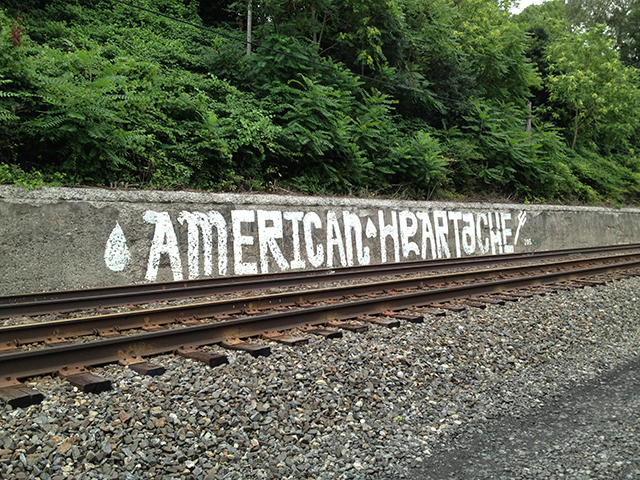
in the past couple years, i have also been in contact with Droid 907, a graffiti writer who continues to blow me away as he expands his repertoire, exploring a wide-range of hardcore graffiti tools; collaborating constantly with other artists and crews on missions, painting larger and larger outdoor pieces while developing unique roller letterforms, as either clean-and-bright two-tone pieces, or wacky and crude expressionistic letterforms; expanding his already-wide geographic perimeter through a network of bike maniacs, van nomads and freight hoppers, poetry in motion, all dedicated to an off-the-grid DIY lifestyle making music and art, publishing zines and encrypted web pages, curating shows and running galleries, while also managing exposure on the internet through a network of friends, fans, and a sympathetic media community.
in the previously mentioned paris travelogue, i was snarky at one point about the overuse and meaninglessness of the term “Punk” forty years after it’s inception; but here i am just a week later reading statements by and looking at photos of Droid’s work, which have, in total for me (including other interactions with him over the past three years), imbued the term once again with its original anti-status quo meaning, a symbolic power derived from IRL transgressive action, off-the-grid DIY work ethic and alternative lifestyle, and blunt radical political statements. to sum up: Droid gives Punk meaning again. this may even be a sign of something else brewing, the crest of some building resonance, the immediate unseen and unrecognized now pregnant with singularity and tumescence, rearing itself up from a minority to a majority, no longer a whisper but a shout. from a third-person vantage point, reading the accruing signs, Droid’s memoires and photo essays, as well as his friend’s zines and other media, such as Avoid’s Vagrant Space website and the novel Train To Pokipse by Rami Shamir, are a bold collective attempt at creating a transom-window visionary-view statement about the growing youth underground in America that in another ten years, as the chasm between rich and poor continues to grow unacceptably wider and future opportunities are proactively hoarded by the one percent, may well become the angry fist of a job-less, cash-less, CPU-less, homeless, transient mass culture with no where to go but off-the-grid onto unregulated topology, creating a new kind of culture that will not be based in anaesthetization in front of a computer screen or by an American Dream that is unattainable for 99% of the population.
so, having Droid on my mind while i was thinking about what to ask Stikman, i was struck by how differently these two artists express themselves with their work on the street, and wondered how two such distinct personalities ended up choosing the same illegal alternative channel to broadcast their message. Graffiti and Street Art can be defined abstractly as a channel, a broadcast media, an alternative wavelength that also imbues the signs transmitted through it with an aura of rebellion under a Halo of Illegality. therefore, since the Medium is the Mess, this particular media manifests an inherently anti-status quo, anarchistic and revolutionary signal and sign. this added layer of outlaw semiotic definition is embedded in the remnants of the art on the street and in the photographs of the art on the internet by the indications of the transgressive action that took place in the placement of the symbols illegally on an unsanctioned display surface. this is the heart of art placed on the streets, the human pulse of the populace, the urge to take back our surveillance reality, re-manifest ourselves through coordinates of insurrection, and visual civil disobedience.
the Illegality of graffiti and street art is a crucial formal aesthetic category at the root of the movement’s cultural power, strategic operations, aesthetic forms and choice of materials. the choices an artist makes from this selection of options defines their personal vocabulary with which they symbolically define themselves and express their message. etch tags or wheat paste? spray paint or rollers? fame spots or cutty hideaways? freights or walls? quantity or detail? stickers or extinguishers? construction sites or high end retail? some materials are contentious, but can be offset by other elements in play. each makes a statement about the artist, their temperament, their strengths and their intentions. so why and how do artists as different as Stikman and Droid express themselves on the same illegal broadcast channel?
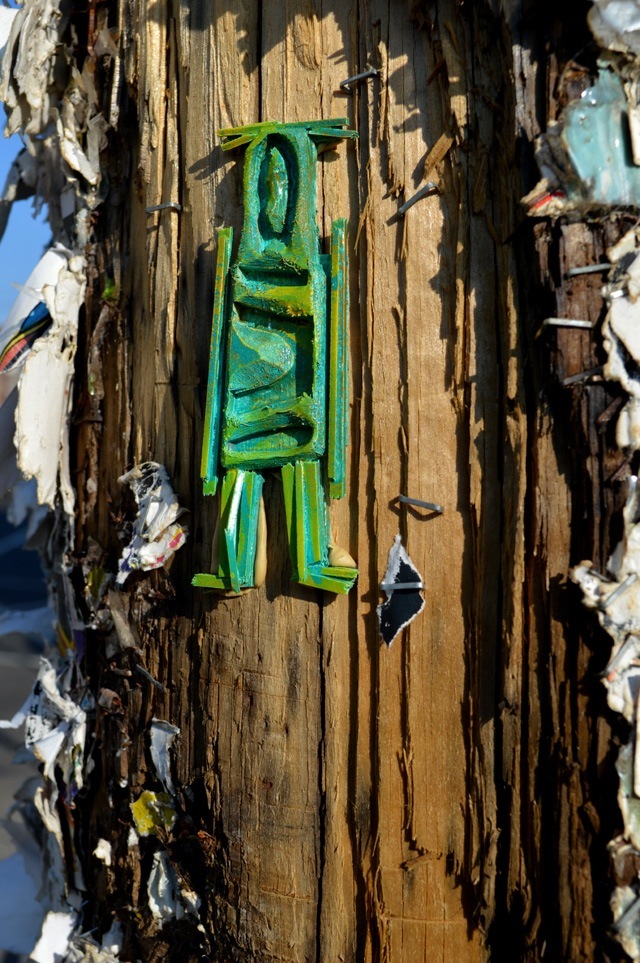
i sent Stikman and Droid the same twenty questions, each consisting of three-to-four more increasingly specific sub-questions on a similar theme; so in essence i sent them about sixty questions total. as i was crafting them, i did not really think about how much i was asking of them, so i want to emphasize that i appreciate their time and effort. it meant a lot to me that they wrote so much detailed, thoughtful and inspiring text. as well as RJ for the suggestion to combine the answers underneath each question. i’m sure it took a lot of time to format, and was well appreciated. thank you.
i’d also like to mention that both Stikman and Droid expressed mutual admiration for each other’s work when i first raised the idea to them. if forced to make this kind of comparison, each of them fall onto opposite ends of the Graffiti and Street Art spectrum, but, at the same time, because of their unique aesthetic paths, they are also outsiders within their designated categories. so mutual awareness makes sense: in the presence of Art, categories collapse and unique minds recognize each other. for instance, when it comes to street operations, Stikman is basically a solo agent on the streets and a ghost on the internet with no self-directed presence except through fan photography and gallery representation; where as droid is constantly painting with different partners, as well as utilizing methods to stay off the grid that involve multiple subcultural supports and many layers of socially-engineered encryption when utilizing the internet. for Stikman, who is celebrated more often in Street Art contexts, he is still a complete enigma in that subculture, because of his refusal to show his face in public or do legal walls, even during his own solo shows; similarly, Droid could be considered a Graffiti outsider from a traditionalist’s viewpoint because of his dedication to the raw power of rollers, an underground comix aerosol aesthetic, and a strong political voice in a movement that usually counts on the aesthetic transgressions to speak for themselves.
important to note is that any truly singular voices, such as Stikman’s or Droid’s, frequently are quarantined in a marginalized cultural space until enough mass-market interest makes it economically feasible for the mass media to broadcast it; but on the other hand, this gives culture-at-large some time to assimilate difficult artist’s visions from the ground up. ironically, this is usually due to a significant portion of the mass population already being altered by, or at least familiar with the artist’s message through the artist’s personal subcultural osmotic-homeopathic resonance which eventually vibrates up to the mass cultural level. an attempt at a flow chart illustrating such relationships between artist’s fame and cultural demand would be fascinating: it is impossible to hold back a resonant aesthetic form when it speaks using the pertinent vocabulary of an era. due to their own particular aesthetic voices, or simply because of their utilization of and dedication to the Graffiti and Street Art broadcast mediums, Stikman and Droid may be recognized as artists historically at ground zero, relevant to cultural discourse, symbolic expressions of a time period, ideal examples of new technologies manifesting aesthetic forms, visual metaphors that summarize the feelings of the majority of the populace, but above and beyond all that: i see Stikman and Droid at their cores as enduring flames in a flat-lining world.
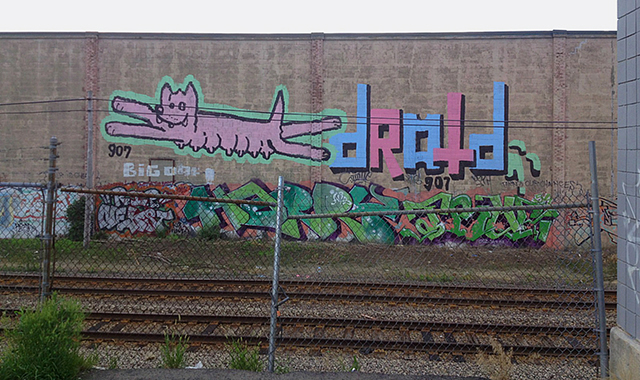
egk: when and where did you first get up?
Stikman: When I was 15, I wrote my name in black paint with a paintbrush all over town like everyone else I grew up with. It was in an older inner ring suburb of a large city in the Northeast US.
Droid 907: the first writer i got up with was DESIGN NFO from brooklyn in the mid 90’s. i was broke and new to the city. the subway was still free and one could venture all over town with no money. he put me down on $35 ounce weed spots in harlem, basically showing me how to make a buck and keep my head above water. he’d write his name whenever he felt like it, regardless of who was around, and pass the marker or can to me and expect me to do the same. it was a different time in new york city for sure. i wrote a different name then and met a number of city kids who all wrote tags. i kept scrawling and scribbling for a few years, as more of an aimless act than one with a mission or purpose. it was more like graffiti found me and it took me awhile to understand it. it wasn’t until 2003 that i did my first roller with FIYAH EMP that i got deeper into the organism.
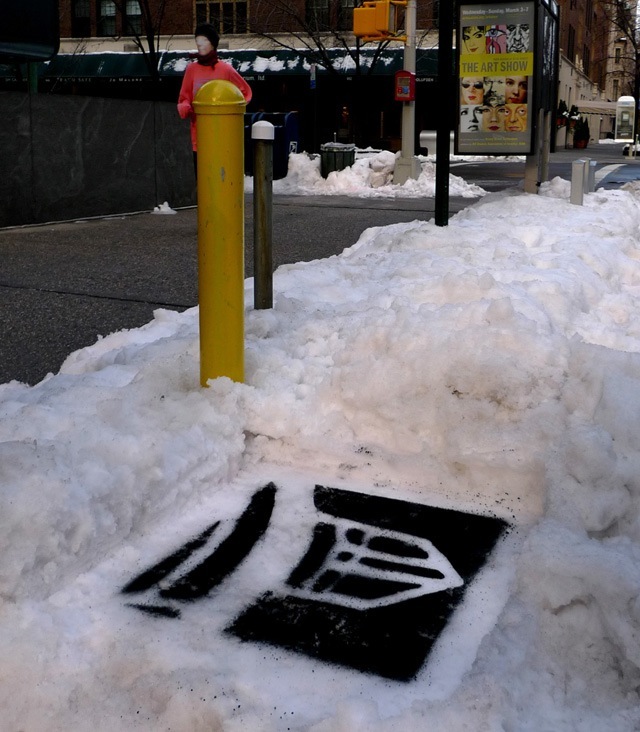
ekg: on reflection, what would you say the motivation was?
Stikman: I have no idea. I was 15 and I spent all of my non school time out in the streets. I got restless being inside. My world was the exterior.
ekg: at the time, were you conscious of being attracted in particular to the illegality of the art form? or were other things more important?
Stikman: It wasn’t an art form. It was kids expressing their power by marking things that adults couldn’t protect. At that time the stone and stick towers that I built were the only intentional artistic impulse that I had.
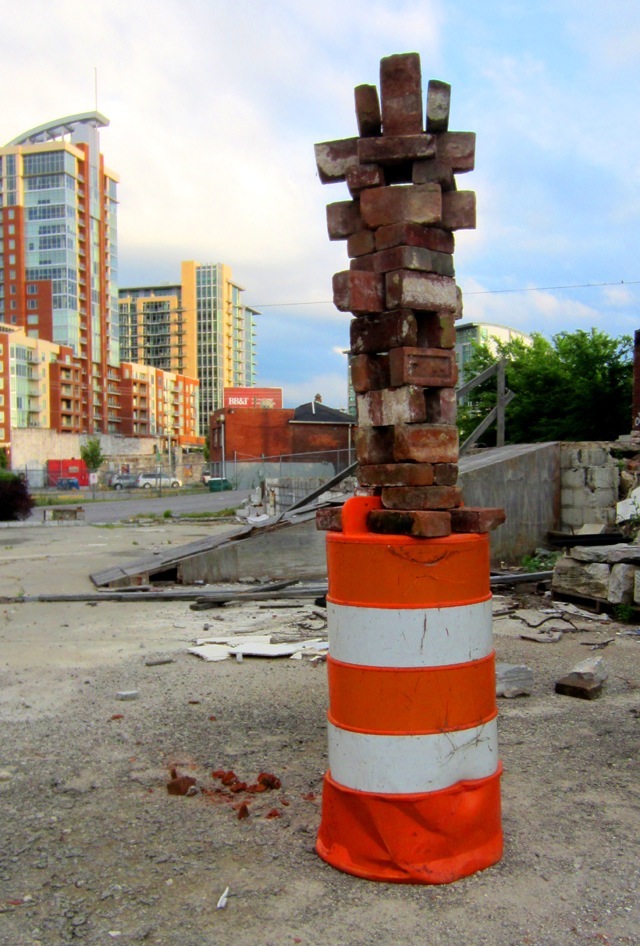
ekg: do you consider yourself a graffiti writer or street artist? is the distinction important to you? what attracted you to one or the other title? was it simply an instinctual alignment or was illegality distinctly important to your decision?
Stikman: I consider myself to be an artist. From my perspective, looking at all I have done and what I do every day I just see a person following an artist journey, making art and spreading it around for other people to experience. I think many artists have followed this strategy throughout the history of art.
Droid 907: first and foremost i am an artist. i practice various disciplines but as far as graffiti is concerned i am a vandal and graffiti writer. it is not a title i took upon myself, rather i paint without permission and where i choose.
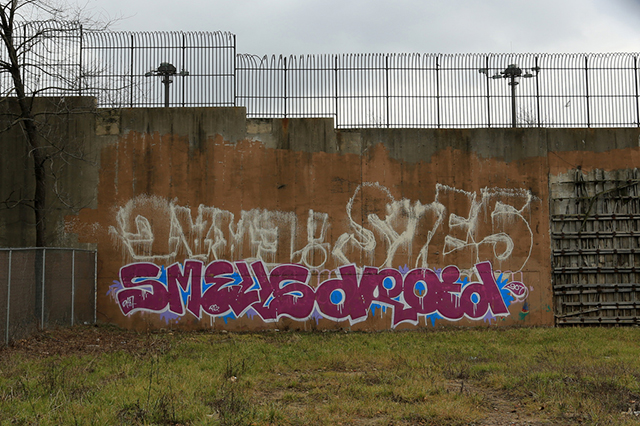
ekg: what are your favorite materials to use on the streets?
Stikman: Sticks. Bricks. Stones. Distressed elements of civilization. Formerly useful things that are now abandoned. The mysteriously hypnotic visual field of asphalt. Paper, glass, wood, book pages, plastic, glue….
Droid 907: i believe that being well versed in all forms of graffiti is probably the best approach to the game – from cutty white out tags and stickers, to street fills and rollers, to trains and piecing. i wont claim to be the best at any of it. in fact i’ll be the first to say i’ve kinged the toyest shit ever, and i’m quite okay with that. my daily routines include making stickers, sticker bombing and tags, bathroom scratchies, and hopefully a spot (or lurking one out at least).
ekg: why did you choose them over other options?
Stikman: Whatever works in any given situation.
ekg: do you feel one tool contains and transmits a different statement over another?
Stikman: I guess it could. A familiar piece, like a page from a popular illustrated book, could evoke one kind of response in the viewer. I think the response could be very different from viewer to viewer depending on that person’s previous relationship with that book image. An out of place element, let’s say a mirror, could cause the viewer to question why they were seeing this on the street or some other response to the oddness of it.
ekg: does illegality or aesthetics influence your choices more?
Stikman: I strive to interact with the environment in an improvisational way. I carry a pallet of visual options with me and employ them in a way I see working in a delineating expression. On a personal level I seek to flow within the environment I am working in and striving to become one with my surroundings. This frees me to express the flashes inside of me that allows our minds to live in a reality that normally escapes us. My hope is that I can convey this moment to the viewer.
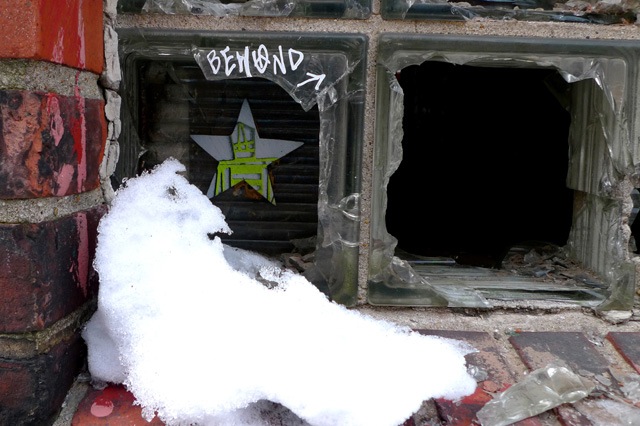
ekg: placement is also another category of the artist’s vocabulary that can make a strong statement about the intent of their art. what do you feel you say with the spots you choose? how do you choose your spots?
Stikman: The brain is among the most complicated things in the universe… so that is where I aim to place my art. Also see answer above.
Droid 907: i appreciate a spot where the work will transmit something both transgressive but also be valued or transcend something meaningful to the audience. that’s why i value cutty spots. the pure transgressive and more illicit does have its place and is quite important in the tradition of the practice. i think in new york, economic warfare is an important practice in graffiti, and that individuals doing etch tags and still hitting people in their pockets with fire extinguishers is very important – it’s not my usual practice however. i stay up primarily with covering a lot of ground with my rollers, keeping my little tags everywhere and making sure to have a good sticker campaign every year or so. i think introducing innovative techniques, crowning spots with huge rollers and spending time for a tight execution, usually out weighs the mere fact of getting up. that said, there’s nothing like crazy drippy belligerent tags.

ekg: how do feel about creating art indoors in a studio or gallery? what are the differences between how you feel and think while you create on the street versus indoors?
Stikman: I’m creating all the time. Some of it stays in my head. Some of it stays in my computer. Some of it makes it to paper or canvas. Some of it ends up in objects. It is all taking me for a ride and I can’t differentiate between this category or that. It all just is. I do always paint outside. I like having the sky over my head.
Droid 907: i believe in punk aesthetic and application. the streets demand a keen awareness of the moment and discomfort provokes critical thought. the streets are just that. inside any art i create i like to value it’s temporal nature and the fact that nothing belongs to oneself fully. too many individuals hold on to their art too closely, and it shows because the life is being squeezed out.
i wake up an artist and go to sleep as one.

ekg: how do you like to operate?
Stikman: Walking around for hours on end.
ekg: do you work alone or with others in any way? are you part of a crew?
Stikman: I work mostly alone with some assistance from an occasional partner. I do like to think that I work with others in the sense that when I lay a piece into a wall that is already coated with art that I am contributing to a greater masterwork that is much bigger than me (and my project) and is growing and evolving within a community of art.
Droid 907: i like to write with the same company i like to eat with. i can say i am lucky to write with individuals whom i genuinely love and can say that 90 percent or more of those whom i’ve written with, i actually feel love for. the same can be said about the crews i am apart of. they are composed of some pretty positive individuals, and that positivity is important to have in this world. it’s also just as important to cook a good meal for yourself sometimes, and walk the streets alone. it’s good to get chased by yourself, get trapped in a lot and figure shit out without the paranoia of two or more minds.
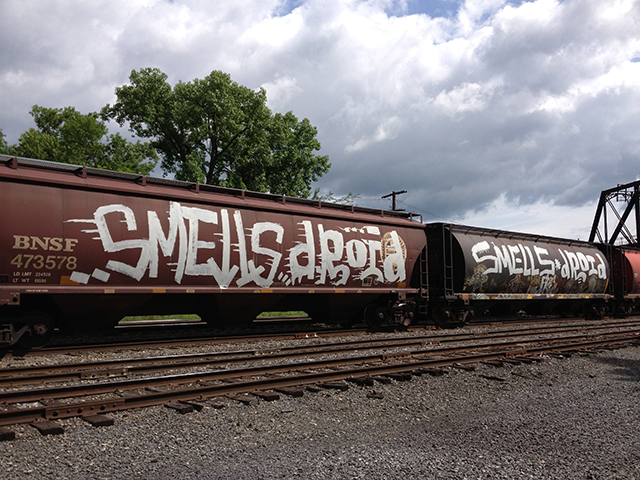
ekg: why is it important to you to work alone or with others?
Stikman: I work alone because I am impulsive and impatient and I tend to walk fast.
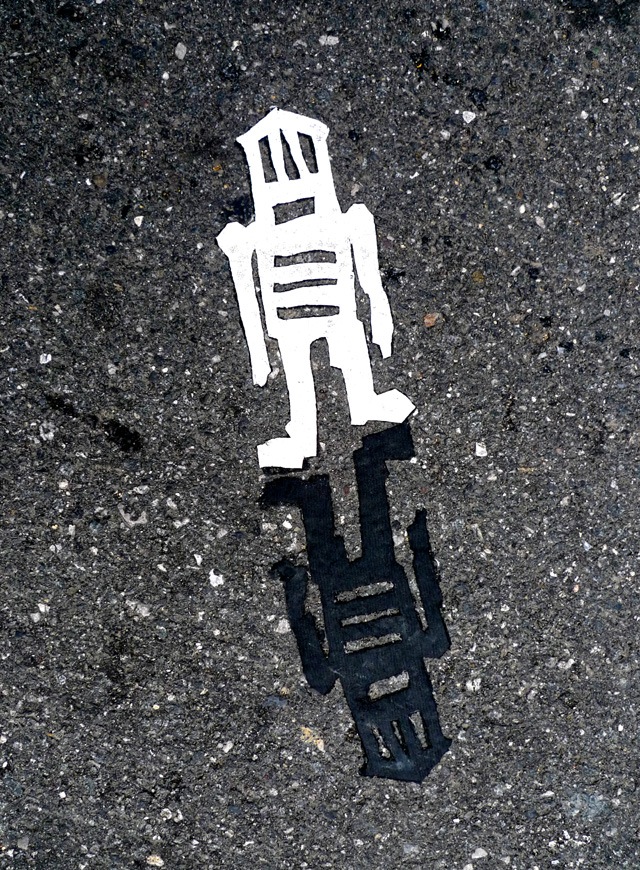
ekg: do you see differences in the way “graffiti writers” and “street artists” deal with illegality on the streets? in the media? utilization of the internet for communication and promotion?
Droid 907: anonymity seems less of a concern to those who prescribe to the street art game than vandals and graffiti writers, whom tend to guard their faces and names a bit more seriously. the main reason being that street artists tend to use their public work as a way to start up a career or get inside the gallery game. it’s done through nepotism and handshakes, and it requires disclosing what pretty smiles they have.

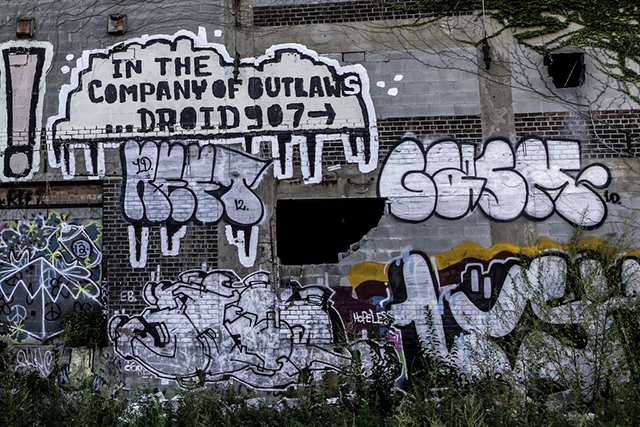
ekg: what do you think about the designation of graffiti and street art as vandalism? (spray paint applied illegally is now considered a felony in some states.) how would you define yourself in relation to that label: Vandal? do you use the term in reference to yourself or your work? are you proud to be a vandal or would you emphasize the importance of the illegal elements of your art with another kind of vocabulary?
Stikman: I see it all as noncommissioned public art. There is a long history marking common space going back to before there were ordinances against it. It is extralegal at its core. It is integral to the human and tribal experience.
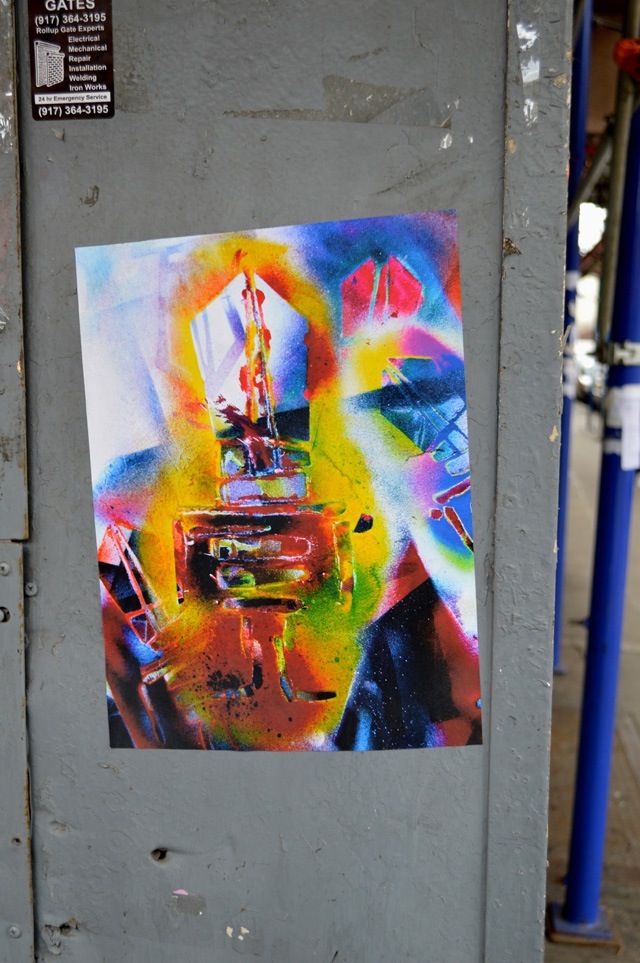
ekg: how does being an artist that practices an illegal art form effect your daily life? do you run your life like a member of the mafia or assume you will pass under the radar even if you are on the internet regularly and have Ig and Fb accounts, a website, etc?
Droid 907: the writer’s daily routine becomes graffiti. you’re not a sight seer, plugging along with a camera around your neck looking at tourist traps with a bunch of cows. you’re forever on the lurk and this includes acquiring materials and scoping spots (both of which require illicit activities) and my practice also includes travel and leisure and avoiding having a job.
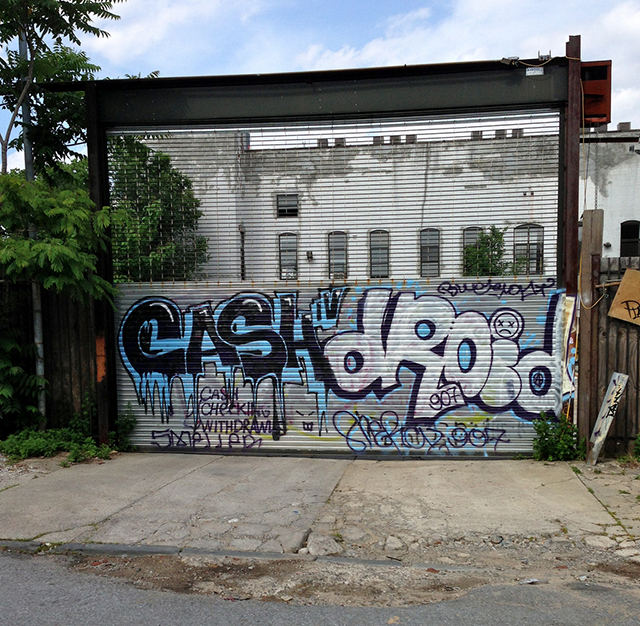
ekg: how do you stay off the grid so you can’t be traced? how do you deal with media attention so that your hard-lived anonymity will be preserved?
Stikman: The media is not paying attention.
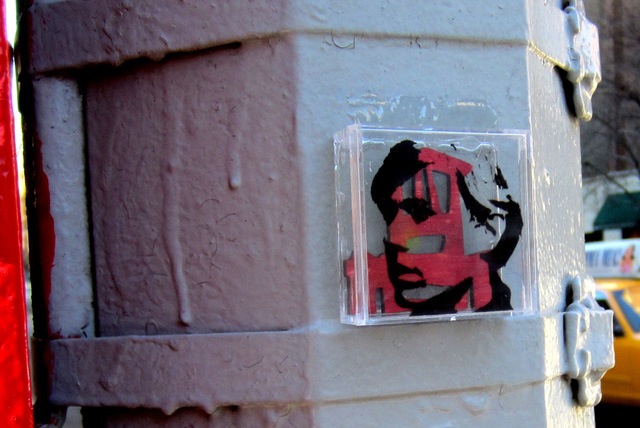
ekg: do you think that the illegality of the aesthetic actions you take on the street is important to your message as an artist? why is the risk of jail time and an arrest record worth it for you to broadcast your art to the public? does the implied risk add something to the power of your art or message?
Droid 907: the risk of oppressive authorities just happens to be part of the process of doing graffiti. i can’t say either way if it’s worth it or not going to jail. i’ve heard friends say that the tag they caught in central booking or the courtroom kind of legitimized the whole ordeal of getting bagged. historically though, villains are heroes in the context of a lot of crime. the bad boy always gets the girl, or so it seems.
ekg: have you been arrested? were you aware of what the legal process would be like before you went through the system? had you prepared ahead of time in any way? did being arrested effect your future work habits and aesthetic practices on the street? if at all, how did it effect you mentally and emotionally?
Stikman: It’s a bummer and a distraction to get sucked into any dehumanizing system, be it the legal system or the ARTMARKET.
Droid 907: getting arrested is part of it. i admire the small few who pull off a substantial graffiti career without ever getting caught. i don’t know how they exactly do it, but i can attest to them as being sober individuals who are extra careful. painting drunk gets you bagged, this i know.
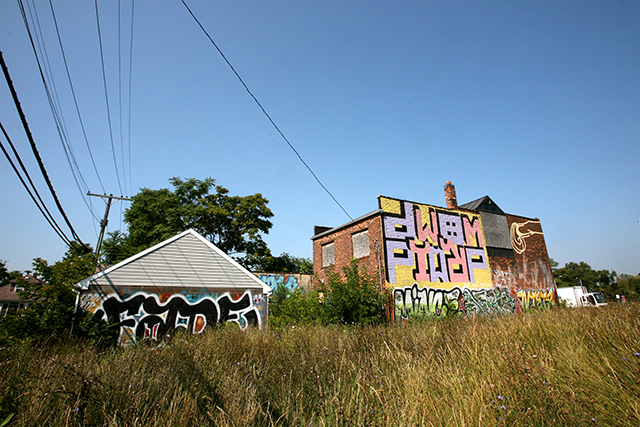
ekg: do you think some marks made on the streets are less or more vandalistic than others? are some more appropriate or acceptable than others? are there some kind of marks you would never make for any reason? is this even a consideration?
Droid 907: i can fairly say that i’d never associate my tag with a corporate brand, say like urban outfitters. street art is typically a way for an artist seeking an entrance to a career in art or banking or whatever commerce. i have a certain disdain for it because of this. it took me a few years to understand what i was doing with graffiti, but it’s never been in an attempt at making money or bettering a “career.”
once i tagged a church blacked out on alcohol and felt horrible for doing it and once i tagged a police station blacked out on alcohol and felt great for doing it. the subconscious works in mysterious ways.
ekg: do you think an illegal mark is more effective than a legal one? does an illegal mark make a stronger statement than a legal one? is one more important to you than another?
Droid 907: the individual who makes himself heard, regardless if they have the millions of dollars in backing that it takes to fund an advertising campaign, is heroic. throughout time the “writing on the wall” has usually come from dissident voices and the underdog who goes against all odds to be heard, will forever be admired in the eyes of the people. if this was not true, you wouldn’t have folk heroes like CORNBREAD, DONDI, COST, REVS or legends like NEKST.
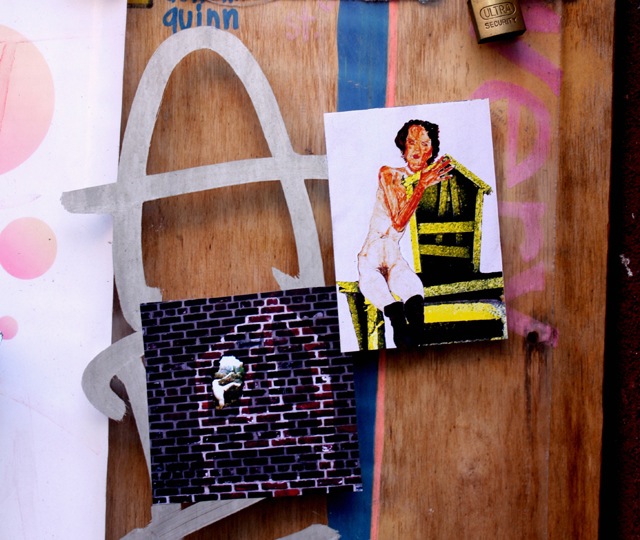
ekg: is one illegal mark more illegal than another in your rule book? does the amount of vandalism aka the physical damage and devaluation of property effect that classification? for instance, do you think an etch tag is perceived differently than a wheat paste by the general public and the authorities? do you choose your materials with these considerations in mind?
Stikman: I don’t have a clue about the thought processes of the general public.
Droid 907: i’ve played around with different materials, and am conscious of what alerts attention and gets you the type of attention that can get you bagged. writer’s that etch are quite conscious of the consequences, and i think that’s why seeing AVONE, MAP or TROOL23 tags on subway cars brings an inspirational tone to an otherwise dull transit. if you have ever stumbled across a REVS on the J/M/Z line, in one of those nooks under a window, you know exactly what i’m talking about.

ekg: do you make a distinction between personal property versus public property? is one more acceptable to write on than another? does the fact that we pay for public property with our taxes make it more acceptable to write on?
Droid 907: i’ve been struggling with the idea of property for years. in proudhon’s anarchist doctrine “property is theft” he asserts the idea that slavery is to murder as property is to theft. it’s quite difficult to me to uphold the value system that stole manhattan from the native americans for a handful of beans, and then has the audacity to throw property laws in the faces of the citizens who slave to keep the island afloat. the idea of public space is a farce. you have no rights in the eyes of the law, and the constitution is a thing of the past. you can paint the walls of your home, if you are lucky enough to afford to have one, but if you think your tax dollars buys you the rights to do the same in public space try and write your name on the white house and see what happens if you get caught.
“this land is your land, this land is my land” is the theme song for a corrupt government who has raped and pillaged its native people and committed acts of terrorism all over the globe.
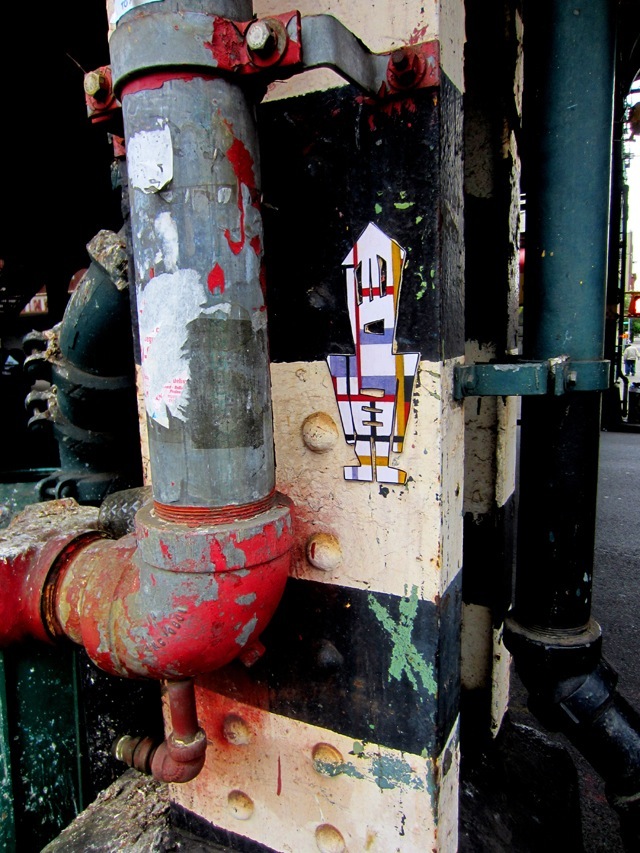
ekg: graffiti and street art are inherently anarchistic in nature because we don’t take a vote or ask for permission before we paint a wall. legal walls are sanctioned, regulated and programmed by property owners and municipal programs. do you think a legal wall loses symbolic power as a sign of rebellion and revolution? can style and detail, or some other element, make up for the loss of the frisson of illegality? does it matter?
Stikman: Legal walls can have very important and symbolic meaning but I don’t think that has anything to do with rebellion or revolution.
Droid 907: one has the ability to create a poignant anti authoritative message whether legally or illegally but unfortunately the street art community in many ways adheres to such a safe limitation of content, style and innovation. it’s not that far off from how the law persecutes graffiti in general. AVOID has been chastized in the past by the same people who ask him to get down on legal walls. why? because he steps to the wall with a message that usually reflects a distaste or opinion of many of those who are taking part in the system (the same safe system that much of the “street art” vocabulary exists in). another problem with the street art game, is that it’s the same work over and over again. the same artists are painting the bushwick walls painted the madrid walls and the baltimore walls, and so on. perhaps those curating these projects believe that innovation goes wasted on the public, when in reality innovation gets wasted on individuals who have limited thought capacity. it was a real shame to see the SPECTER’s stunningly beautiful and ultra realistic bodega piece (in bushwick) get gone over by some repetitive street art you’ve seen a hundred times already.
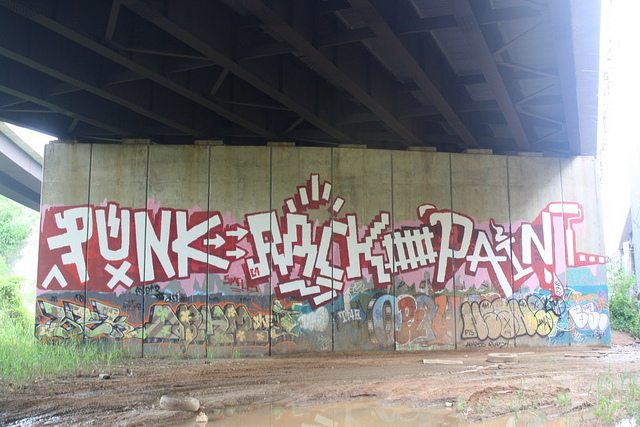
ekg: graffiti and street art are generally represented purely by style and materials when presented in gallery setting. do you think there is another way to apply the essence of graffiti or street art as represented by illegality in the gallery? what kinds of things, actions, materials, props, processes, algorithms, could not only illustrate and represent the icons and motifs of graffiti and street art like current gallery shows, but actually bring the actions, the risk, the transgression, the essence of illegality into a regulated white box setting? maybe you don’t care about gallery issues at all?
Stikman: I don’t. What I present on the street and what I present in a gallery all come from the same place inside my head, where I have the freedom to have nothing to say. If that does not meet some peoples expectations of my work they may be thinking too much about it.
Droid 907: graffiti is typically boring inside a gallery setting unless there is an obvious innovation occurring. it’s usually however the same photos of illicit activities (vice magazine rip offs) and canvases with far less appeal then the work on the street.
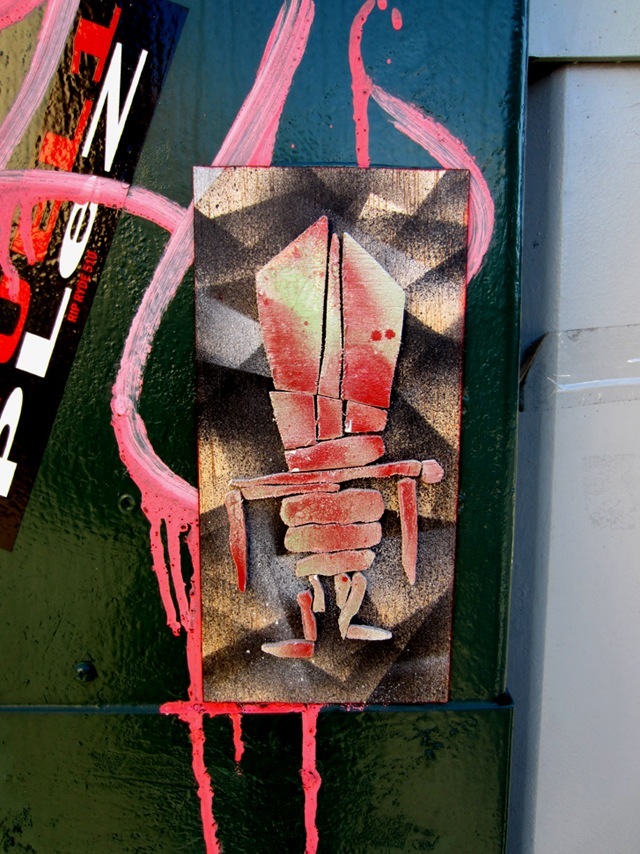
ekg: it is the defacement of property, the loss of value, that is a big issue for the general public. do you have any objections to capitalism and private property as an economic system? how do you feel about the #ows movement?
Droid 907: my mother argues that if i willingly do graffiti, knowing that it is a high profile crime these days, that i am actively taking police attention off the “real crimes” just as much as those who are re-prioritizing how crime is patrolled. true to an extent, but the police as individuals have a choice of finding real crime or adhering to climbing the career ladder with receiving collar points. the police are just as ignorant as bloomberg and vallone’s re-prioritizing. they are slaves to the system. if someone handed me a gun and told me to waste my whole day and hunt down crime in the streets, and the streets gave me a choice to capture a rapist or violent maniac, i wouldn’t come back with a graffiti writer. they have the choice. the crime is still present in the city. one just has to go to bushwick where gun shots are still heard quite frequently and where it’s easy to see how the police are systematically removing citizens who’ve been there for decades and harassing the artists in the community. it’s in an effort to make money, get rid of the old new york and make way for a new new york.
ekg: do you have any final summary or statement that you would want to make about your art or the movement?
Droid 907: don’t obey.
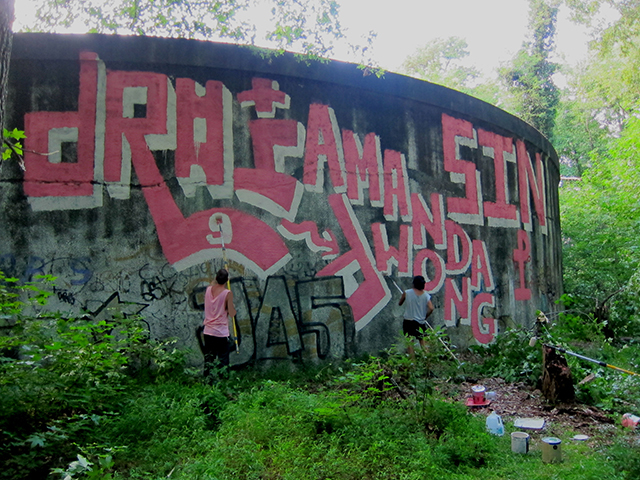
—
Droid 907’s latest graffiti memoire SEX or SUICIDE is available online at Article Method or these locations:
Williamsburg, Brooklyn: Desert Island Books
Lower East Side, Manhattan: Reed Space
Baltimore, Maryland: Atomic Books
—
Stikman’s work can be followed at the Stikman flickr group or the Stikman Facebook page, both fan-run.
—
contact ekg at ekglabs@ymail.com. for multiple daily updates of nyc graff and ekg related activities, follow @ekglabs on Instagram. also still sort of keeping up with facebook and flickr as ekglabs, but they are mainly historical archives at this point. to see and read more abut ekg, check out this artist feature on Graffuturism.com.
—
Photos by Luna Park, Amanda Wong, Sarz TKG, Phil Conners, Danika2, RJ Rushmore, Sin1, Jessica Lundgren, Rhiannon Platt and Stikman
